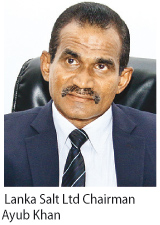
The country will be self-sufficient in salt by 2020, a leading salt producer said.
The Lanka Salt Company expects the country to be self-sufficient in salt as its production will increase with the planned expansion activities. The total investment is estimated to be around Rs. 210 million.
 “The company which has three salterns has embarked on an ambitious expansion project to support the government’s initiative to produce the entire annual requirement of salt locally. With the project in place, the country will be self-sufficient in salt by 2020,” Lanka Salt Chairman Ayub Khan said.
“The company which has three salterns has embarked on an ambitious expansion project to support the government’s initiative to produce the entire annual requirement of salt locally. With the project in place, the country will be self-sufficient in salt by 2020,” Lanka Salt Chairman Ayub Khan said.
The company has three salterns in Hambantota - Mahalewaya, Bundala-Kolankala and Palatupana.
The company has become a profit-making entity under the Yahapalana government. The loss of Rs. 333 million has been made good. The company paid the government Rs. 465 million as tax last year.
“We now have deposits worth Rs. 500 million in the company name,” he said.
The company became a limited liability company in 1990 and 90 percent of the shares are owned by the ETF and the rest s by the workers. Lanka Salt Ltd had paid Rs. 180 million to the ETF and Rs. 20 million to the staff as share of profits.
“At present we have all the necessary equipment such as escalators and tractors to carry out the new development activities.
The company has developed over 800 acres of land as salt beds and provides 70 percent of the consumption needs of the country. We plan to go for value addition after the country’s consumption needs are met,” he said.
 With the new development activities, the company’s production capacity will go up to 80,000 to 85,000 tons.
With the new development activities, the company’s production capacity will go up to 80,000 to 85,000 tons.
The country’s total requirement of the salt is 120,000 metric tons and the other salt requirement is 150,000 metric tons.
The production capacity has increased from 1,200 metric tons to 5,000 metric tons at present.
Among the other development activities are the setting up of a vacuum plant and a sales centre to sell Lak Salt brand for the consumers shortly.
There is a vigorous process to make the end product.
The sea water is transferred in to salt beds where it is being kept to absorb Magnesium. Then the salt is formed and it is extracted from the ground.
When the salt is washed, pollutants and metal particles are removed through a magnetic belt and then the salt is ground and dried thoroughly. When its density is 28, the salt is ready for consumption.
The salt is broken into small pieces and mixed with iodine in the range of 15 to 30 pp million. The salt is harvested after three months of sea water evaporation.
The table salt in your saltshaker and the salt used in food production is the end product of a two-step process of extraction and refinement – called Solution Mining and Brine Evaporation. In solution mining, salt is extracted by forcing water under pressure into a bore-hole drilled into an underground salt bed or dome.
The salt dissolves, turning the water into brine and creating a cavern in the salt-bed. The brine is then pumped back to the surface and on to the purification plant where calcium, magnesium and other impurities are removed before beginning the brine evaporation process.
